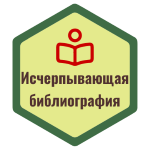The use of smartphones in schools is an issue of concern for teachers, students, and parents alike, as it can have both positive and negative effects on the educational experience. The purpose of this study is to investigate how smartphones are used in private school in Kazakhstan, and to assess the impact of smartphone use on both teachers and students. The study utilized both primary and secondary sources of information to collect data by using literature reviews and surveys. The results demonstrate that smartphones are used for almost the same purposes by teachers and students, but they differ in some aspects related to their activities, and smartphones have more negative impacts on teachers’ work and students’ studies than positive ones.
Keywords: use of smartphones at school, positive effects of the smartphone, negative effects of the smartphone, the effect of smartphone on students, effect of smartphone on teachers.
Introduction
The widespread use of smartphones in recent years has changed the way people interact with technology and with each other. However, the integration of smartphones into the education sector is a topic that has received a significant amount of attention in recent years. The utilization of mobile devices in educational institutions is a matter of apprehension for educators, learners, and parents alike, due to its potential to yield both beneficial and detrimental outcomes on the academic journey.
The purpose of this research paper is to investigate the ways in which smartphones are used in private school in Kazakhstan, and to assess the impact of smartphone use on both teachers and students. The relevance of this issue is apparent, as the use of smartphones in schools is becoming increasingly prevalent and it is important to understand how it is affecting the educational experience.
The background information of this topic reveals that smartphones are being used in various ways in schools. For example, some teachers are using them as instructional tools, while others are restricting their use to only during certain times of the day. At the same time, students are using smartphones to access educational resources and to stay connected with friends and family.
The issue of smartphone use in schools is multifaceted and can have a variety of effects on teachers and students. For example, the use of smartphones can increase student engagement and motivation, but it can also be a source of distraction and can negatively impact academic performance. Additionally, the use of smartphones can also have an impact on teachers, who must find ways to incorporate them into their instruction while also managing potential distractions.
The evidence that this issue exists is clear and comes from a variety of sources. Studies have shown that the use of smartphones in schools can have both positive [2] and negative [5] effects on student achievement and teacher job satisfaction [9, p. 13]. Moreover, personal experiences of the researcher suggest that the use of smartphones in schools is a complex issue that requires further exploration.
The motivation behind this research paper is personal, as the researcher is a student at private school and has experienced the effects of smartphone use in the school environment. Through this research, the researcher aims to gain a deeper understanding of the issue and to contribute to the larger conversation about the appropriate use of smartphones in schools. By exploring the ways in which smartphones are used in private school and assessing their impact on teachers and students, this research paper seeks to provide valuable insights that can inform future discussions about the appropriate use of smartphones in schools.
The aim of this research is to investigate the purposes for which phones are used by students and teachers in private school in Kazakhstan, and to examine the impact of these uses on the teachers’ work and students’ study. Through this research, we aim to provide a deeper understanding of the ways in which phones are used in private school in Kazakhstan, and to explore the potential benefits and drawbacks of these uses in the context of this specific school.
The following sub-questions will be addressed in this research:
- What are the most common purposes for which phones are used by students and teachers in private school in Kazakhstan?
- How does the use of phones by students and teachers in private school in Kazakhstan impact the teachers’ work, including their ability to engage students in the learning process?
- How does the use of phones by students in private school in Kazakhstan affect their ability to concentrate, focus, and learn effectively?
These questions will help answer the research question by providing a more detailed understanding of the ways in which phones are used in private school in Kazakhstan, and the impact of these uses on both teachers and students. By exploring the common purposes for which phones are used in private school in Kazakhstan, the insights into the motivations behind their use, and the ways in which these uses can be optimized to enhance the educational experience will be gained. By examining the impact of phone usage on teachers’ work and students’ study, it would be possible to get a deeper understanding of the benefits and drawbacks of these uses, and this will be able to offer recommendations for best practices in the use of phones in private school in Kazakhstan.
Literature review
Today more than 6.8 billion people use smartphones around the world [16]. On average, every person spends approximately 3 hours and 15 minutes on their phone every day [8]. According to Han and Yi’s research [7], roughly 99 % of student in South Korea has a modern smartphone with many functions and possibilities, which can be used anywhere, and anytime. In Nigeria students between 18 and 24 use and access their phones 214 times a day and 1500 times a week [6].
There are five main categories of academic smartphone usage: sharing course materials, assessing university learning management systems, interacting with students, information searching, and setting reminders for various course-related tasks [9, p. 7]. By these categories the teachers’ and students’ perspectives on using a phone in education can be understood.
The phone can be displayed differently in the study of students and the work of teachers. Ma’azer and Jusoh had interesting findings in their research about the use and effects of smartphones on academic staff at a university level, especially in the Kingdom of Saudi Arabia [15]. The survey was conducted by using questionnaires. In accordance with result illustrates that a smartphone has been used as an alternative to a computer or laptop, a digital camera, a watch, and digital storage by teachers. An email system which used during the day is the most useful smartphone app for academic staff and teachers.
Also, the use of mobile promotes them enables easier communication, better organization, and internet access, thus better-connecting students to their families, friends, and teachers [11]. In the research of Balliammanda, the majority of teachers believe that using smartphones would benefit academic learning [3]. As the students can look at the information on the internet, due to the research skill, which they can do in the classroom, going to improve their critical thinking skills and their proficiency, and digital literacy can be ensured because it makes such a strong influence on the students. Furthermore, smartphones are extremely useful for teachers because they allow teachers to control students’ learning in real-time [14].
Smartphones are extremely adaptable; students can use them at any time because they are always with them and always on [12]. In addition Tessier found that smartphone use as an education tool could benefit learning too [18]. The study evaluated university students’ points of view on the use of mobile phones as academic tools in the classroom. The result showed that students felt that mobile phones helped them learn, encouraged their enjoyment of classes, improved their progress in the course and slightly increased their attendance, claims that a class that does not use mobile technology would be completely uninteresting, given the role they play in the daily lives of teenagers. The positive impact of smartphone addiction on students’ academic performance may relate to the shift in social practices that normalize excessive smartphone use.
Despite this, smartphones have more disadvantages than positive effects. The multitasking space of smartphones is frequently blamed for the link between smartphone use and poor academic performance. To account for the effects of multitasking on academic performance, Junco and Cotton investigated the relationship between multitasking on phones and student academic performance among college students [10]. This study found that sending text messages and checking social media websites like Facebook while performing an academic task or doing homework interfered with their ability to complete their schoolwork and had a negative impact on their overall GPA.
Mayer and Moreno present a cognitive theory of multimedia learning that can be applied to the study of multitasking engagement and academic performance [13]. They argue that human memory’s ability to process information from multiple channels is limited. Because of this limitation, meaningful learning necessitates a significant amount of cognitive processing for learners to organize the learning materials into a coherent structure and integrate the same materials with their existing knowledge to produce meaningful knowledge. Meaningful learning is defined as a «deep understanding» of the presented learning materials «reflected in the ability to apply what was taught to new situations» and the application of various problem-solving models in response to a wide range of existing and novel problems [13, p. 43].
Another factor of low student achievement is a decrease in motivation to perform academic work due to the phone. Among other things, it has been suggested that there are many entertainment applications and social media platforms that can interfere with learning and lead to procrastination, such as watching videos, games, or texting [1]. The studies of Sunday et al. support this conviction [17, p. 7]. The analysis included 44 studies (45 effect sizes) and 147,943 students from 16 countries (e.g., Brazil, China, Italy, Lebanon, Nigeria, Turkey, United States). These findings indicate that texting, talking and chatting, multitasking in class, and text messaging and socializing all have a negative impact on students’ academic performance. The findings show that when a student spends so much time on the phone, he or she neglects daily activities, engages in excessive smartphone use, or texts excessively on the phone, his or her GPA suffers.
The results of Ma’azer and Jusoh also show that academic staff cannot use a smartphone as a means to complete a task faster [15]. Using smartphones in the workplace has had some negative impacts on the work environment, where teachers tend not to focus on their meetings or face-to-face communication with colleagues, since they utilize their smartphones at the same time. Moreover, smartphones are used in higher education institutions to distract teachers from teaching by playing games, watching movies, and listening to music [9, p. 13].
Method
The following research on the purposes for which smartphones are used and how they affect the work of teachers and students in the private school in Kazakhstan was conducted using various methods. The study utilized both primary and secondary sources of information to collect data. The quantitative research design was chosen for primary research. As the design of quantitative research aims to find out how many people think, act or feel in a certain way. Quantitative projects involve large sample sizes, focusing on the number of responses, as opposed to obtaining a more focused or emotional understanding, which is the goal of qualitative research. Because of this, the method for collecting data was survey.
The survey development is the process of creating a set of questions that allows effective data collection and information from participants in a structured and systematic way. Also considering the target audience, the delivery method, and any potential biases or sources of errors. It was successful in gathering quantitative data. For instance, in quantitative studies, researchers conduct a survey of a sample or the entire population to describe views, opinions, and behaviors on the issue under study [4, p. 376]. The survey was standardized, efficient, anonymous, flexible, and affordable. The collected data from the survey as the main source of information played an important role in highlighting the problem and clarifying the purposes of using phones and how they affect the work of teachers and students at private school.
There were two surveys: one for the teachers, and another for the students from a private school in Kazakhstan. All participants were provided informed consent forms and the answers were taken anonymously. The questions in surveys were related to the sub-question of the research. The survey for teachers contained 11 questions and took 4 minutes and 35 seconds on average to complete. The survey for students included 10 questions and lasted for about 3 minutes and 45 seconds on average.
The surveys were conducted via Microsoft Forms platform as with the increasing use of websites and the Internet, web surveys are becoming more and more popular.
The survey was sent to the participants via Outlook since all of them had access to their own Outlook email accounts. In total, 30 teachers and 51 students took part in the study. Surveys offer numerous advantages, they also have significant disadvantages when used as a data collection method. The percentage of responses is the first limitation. They frequently have low response rates. It was critical to make the survey as basic and user-friendly as feasible, as well as to give incentives for participation, in order to raise the number of responses. The second issue was a lack of nuance. Closed questions in survey may not provide enough detail or depth of responses. To address this issue, open-ended questions or qualitative data collection approaches were required.
Results
As for the student participants, the students from grades 7 to 11 took part in the survey. Most of the survey’s participants were from 11 grades and had a good GPA approximately 4,5. The average time students use smartphones is about 5 hours. Which is 2 hours longer than in the Howarth research study [8]. About 76 % of students use regularly phones during lessons.
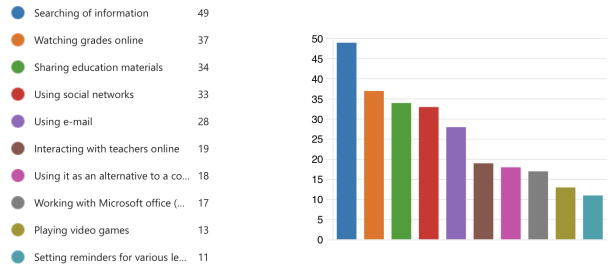
Fig. 1. The purpose of using smartphones by students
The purpose of using smartphones at school by students illustrates in Fig. 1. The result shows that 96,0 % of students use smartphones for searching for information. Approximately 70,0 % of students use smartphones to watch grades online, share educational material, and use social networks. These results coincide with the Iqbal and Bhatti research work [9, p. 7]. Despite this, the purpose of setting reminders for various course-related tasks doesn’t spread among students. Students also noted other goals such as entertainment purposes, communicating with classmates, and cheating in exams.
As for the positive effects of smartphones on studies (Fig. 2), students could not determine whether a smartphone improves critical thinking or not. Although in a study by Balliammanda [3], the researcher determines that the use of smartphones improves critical thinking. 69,0 % of respondents agree with “A smartphone improves digital literacy”. This result coincides with Balliammanda’s research [3]. Kolb noted in his research that smartphones can be used at any time [12]. This study confirms this, as 60 % of the students agreed with this statement.
Furthermore, 49,0 % of students agree that smartphones improve social life and 37,3 % of participants are in a neutral position. 41,2 % of students are in a neutral position, while 35,3 % disagree with the last statement. Because of this, it can be said that smartphone does not improve academic performance. 10 students also additionally noted that the phone is a source of information, which also positive effect.
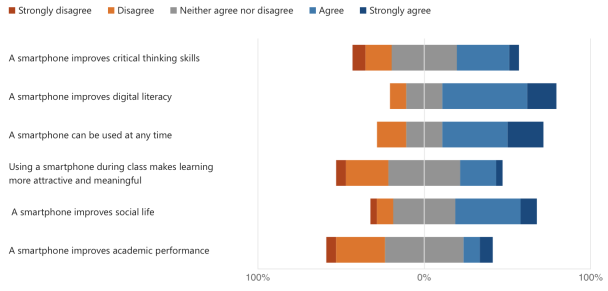
Fig. 2. Positive Effects of Smartphones on Students
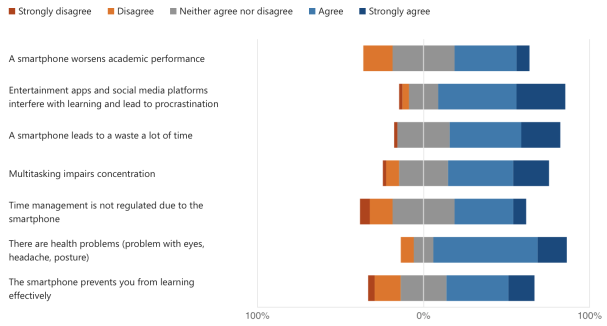
Fig. 3. Negative Effects of Smartphones on Students
In terms of negative effects of smartphones on study the survey had the following results (Fig. 3). 45,1 % of respondents agree that using phones worsen academic performance and 37,3 % are in a neutral position with this conviction. This result is in line with Junco and Cotton’s [10] study that concluded that smartphones lead to poor academic performance. “Entertainment apps and social media platforms interfere with learning and lead to procrastination” is accepted by 76,5 % of students. This result can be supported by the research of Ahmed et al. [1] and Sunday et al. [17, p. 7].
Moreover, only 2,0 % of participants disagree and 66,6 % agree that smartphone leads to waste a lot of time. In this way, a cognitive theory of multitasking impairs concentration of Mayer and Moreno is validated [13]. 80,3 % of participants indicate that smartphones lead to health problems such us problem with eye, headache, posture. «The smartphone prevents you from learning effectively” is agreed by 53,0 % of
students. This notion is supported by Junco, and Cotton’s research [10]. In addition, 3 students noted that the phone leads to addiction and 1 student noted that the phone leads to loss of creative thinking.
The second survey was conducted among teachers from private school. The average teaching experience was 11.6 years. The average time their spent-on smartphone by teachers is about 4 hours and 30 minutes. Despite this, teachers rarely or sometimes use their smartphones during class.
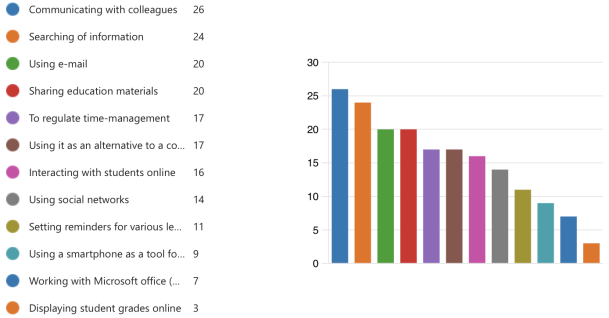
Fig. 4. The purpose of using smartphones at school by teachers
The purpose of using smartphones at school by teachers illustrates in Fig. 4. Most teachers use smartphones for communicating purposes: communicating with colleagues (86,0 %), using e-mail (66,0 %), and using social networks (46,0 %). Another purpose is used in academic purposes related to the research of Iqbal and Bhatti [9, p. 7]: searching for information (80,0 %), sharing educational materials (66,0 %), regulating time-management (56 %), interacting with students online (53 %). Ma’azer and Jusoh mentioned in their research that teachers use smartphones as alternatives to computers [15]. In this research, 56 % of teachers use it for this purpose. Only 10 % of teachers display students’ grades online via smartphones. Tessier found that smartphone use as an education tool could benefit learning [18], but only 30 % of respondents use it for this purpose.
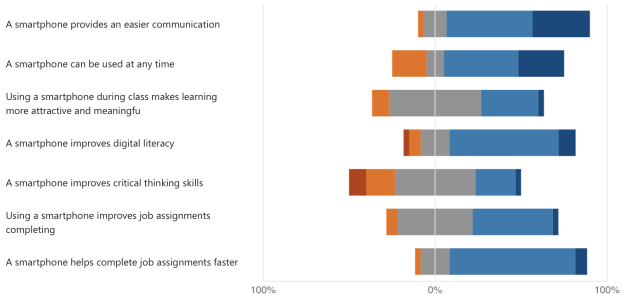
Fig. 5. Positive Effects of Smartphones on Teachers
Fig. 5 demonstrates the result of determine positive effects. Four positive effects were agreed upon by teachers. First, 83 % of teachers accept that smartphones provide easier communication. It was mentioned in Katz’s research work [10]. The second is “a smartphone can be used at any time” (80 %). The third one is that the smartphone improves digital literacy (73,3 %). It lines the result of Balliammanda’s research work [3], which demonstrates the same result. The final harmful effect is “a smartphone helps complete job assignments faster”. Surprisingly, the results of Ma’azer and Jusoh show that academic staff cannot use a smartphone as a means to complete a task faster [15].
As for the rest of the beliefs, teachers cannot decide whether they are positive effects; using a smartphone during classes makes learning more attractive and meaningful (53.0 % disagree and do not disagree), a smartphone improves critical thinking skills (46.7 %), and using a smartphone improves the performance of work tasks (43.3 %). The teachers also replied that the smartphone is convenient when performing urgent tasks and it works faster than a computer.
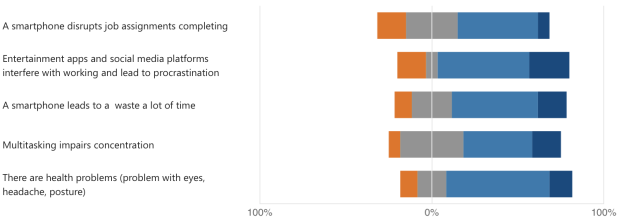
Fig. 6. Negative Effects of Smartphones on Teachers
Teachers’ opinions on smartphones’ negative consequences are shown in Figure 13. Most of participants agree with all negative effects. 6–7 teachers also noted that smartphone contributes to addiction, emotional devastation, curtails physical and social interactions.

Fig. 7. Allowing students to use smartphones during classes
The Fig. 7 shows that more than 50 % of teachers sometimes allow students to use phones during lessons. 80 % of teacher use methods of involving students in the learning process so that they are not distracted by a smartphone. As a result, they mentioned the methods. It is illustrated in Table 1.
Table 1
Types of methods
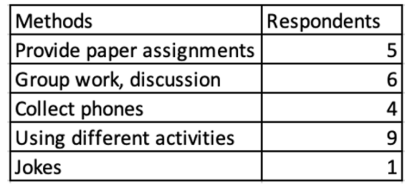
80.0 % of teachers use methods to attract students into the educational process, but they don’t always work. 36.0 % of teachers don’t allow using the phone during the lesson, while only 23.0 % don’t use it. Even though 63.0 % of teachers sometimes allow using smartphones, 76.0 % of students use them in class, as well.
A smartphone helps complete job assignments faster for teachers. Nevertheless, there is a contradiction about how using a smartphone improves job assignment completion. 0 % claim that using a smartphone improves the performance of work tasks, while only 6.7 % reject this. At the same time, 53.4 % of teachers agreed that a smartphone disrupts job assignments being completed, and 16.7 % disagreed.
Conclusion
To summarize all the findings presented above, the following conclusions can be drawn. Students use commonly smartphones for searching for information, watching grades online, sharing educational material, using social network, using e-mail, and interacting with teachers. There are also some other objectives listed, including amusement, talking to classmates, and exam cheating.
Most teachers use smartphones for communicating purposes: communicating with colleagues, using e-mail, and using social networks. Another common purpose is used in academic purposes: searching for information, sharing educational materials, regulating time-management, interacting with students online.
The findings showed that smartphones enhance digital literacy, are always available, make learning more engaging and meaningful, enhance students’ social lives, and serve as a source of knowledge. Despite this, using a smartphone interferes with pupils’ ability to focus, pay attention, and study successfully. Many attendees concurred that using smartphones decreases academic performance. Smartphones hinder learning, cause procrastination, a lot of wasted time, health issues, addiction, impede focus, and reduce the ability to think creatively.
Many teachers believe that smartphones have more of a negative impact than a positive one. However, the main positive effects of smartphones are that they facilitate communication, increase digital literacy, help to complete work tasks faster, and are convenient when performing urgent tasks because they work faster than a computer.
On the other hand, the negative impact of smartphones includes the disruption of work assignments, as entertainment applications and social media platforms interfere with work and lead to procrastination. In addition, excessive smartphone uses leads to the loss of a lot of time, multitasking impairs concentration, and health problems such as vision problems, headaches, and posture disorders may occur.
While some teachers sometimes allow smartphones to be used during classes, many students often use smartphones during class. Because of this, many teachers use different methods to attract the student’s attention to the lesson. Teachers use methods such as providing paper assignments, collecting phones, using various types of activities, and group, and pair discussions. Despite this, they don’t work properly.
To conclude, the answer to the main research question “For what purposes are phones used and how do they affect the teachers’ work and students’ study in private school in Kazakhstan? ” is that smartphones are used for almost the same purposes, but they differ in some aspects related to their activities and smartphones have more negative impacts on teachers’ work and students’ studies than positive ones.
The result of this study has important information about this topic. First, the primary sources gave a complete answer to this question. Secondly, this study covered all the goals set for the study. Thirdly, this study may contribute to the creation of an objective opinion about the impact of smartphones on teachers and students, accompanying another research.
It is important to take additional steps to strengthen the research, like expanding the number of participants in the data collection process, using alternative qualitative and quantitative data collection techniques, and doing localized research. Because it might enhance the study’s relevance and objectivity.
References:
- Ahmed R. R. et al. Smartphone use and academic performance of university students: a mediation and moderation analysis //Sustainability. — 2020. — T. 12. — №. 1. — С. 439.
- Alfawareh H. M., Jusoh S. Smartphones usage among university students: Najran University case //International Journal of Academic Research. — 2014. — Т. 6. — №. 2.
- Balliammanda K. Perceptions of teachers on teaching and learning with mobile devices in higher education classrooms in Oman: A pilot study //Studies in Technology Enhanced Learning. — 2021. — Т. 1. — №. 2.
- Creswell J. W. Educational research: Planning, conducting, and evaluating quantitative and qualitative research. — Pearson Education, Inc, 2012.
- Elder A. College students’ cell phone use, beliefs, and effects on their learning //College Student Journal. — 2013. — Т. 47. — №. 4. — С. 585–592.
- Ezeah G. H., Asogwa C. E., Obiorah E. I. Social media use among students of universities in South-East Nigeria //IOSR Journal of Humanities and Social Science. — 2013. — Т. 16. — №. 3. — С. 23–32.
- Han S., Yi Y. J. How does the smartphone usage of college students affect academic performance? //Journal of Computer Assisted Learning. — 2019. — Т. 35. — №. 1. — С. 13–22.
- Howarth J. Time spent using smartphones (2023 statistics) //Exploding Topics. — 2023. URL: https://explodingtopics.com/blog/smartphone-usage-stats.
- Iqbal S., Bhatti Z. A. A qualitative exploration of teachers’ perspective on smartphones usage in higher education in developing countries //International Journal of Educational Technology in Higher Education. — 2020. — Т. 17. — №. 1. — С. 29.
- Junco, R., Cotton, S. No A 4 U: The relationship between multitasking and academic performance // Computers & Education. — 2012 — T. 59. — №. 2. — C. 505–514.
- Katz J. E. Mobile phones in educational settings //Magic in the Air. — Routledge, 2017. — С. 87–101.
- Kolb L. Adventures with cell phones //Educational leadership. — 2011. — Т. 68. — №. 5. — С. 39–43.
- Mayer R. E., Moreno R. Nine ways to reduce cognitive load in multimedia learning //Educational psychologist. — 2003. — Т. 38. — №. 1. — С. 43–52.
- Manuguerra M., Petocz P. Promoting student engagement by integrating new technology into tertiary education: The role of the iPad //Asian Social Science. — 2011. — Т. 7. — №. 11. — С. 61.
- Ma’azer Al Fawareh H., Jusoh S. The use and effects of smartphones in higher education //Ijim. — 2017. — Т. 11. — С. 103.
- Statista: Smartphone subscriptions worldwide 2016–2021, with forecasts from 2022 to 2027. // Statista, 2023: — URL: https://www.statista.com/statistics/330695/number-of-smartphone-users-worldwide/
- Sunday O. J., Adesope O. O., Maarhuis P. L. The effects of smartphone addiction on learning: A meta-analysis //Computers in Human Behavior Reports. — 2021. — Т. 4. — С. 100114.
- Tessier J. Student impressions of academic cell phone use in the classroom //Journal of College Science Teaching. — 2013. — Т. 43. — №. 1. — С. 25–29.







